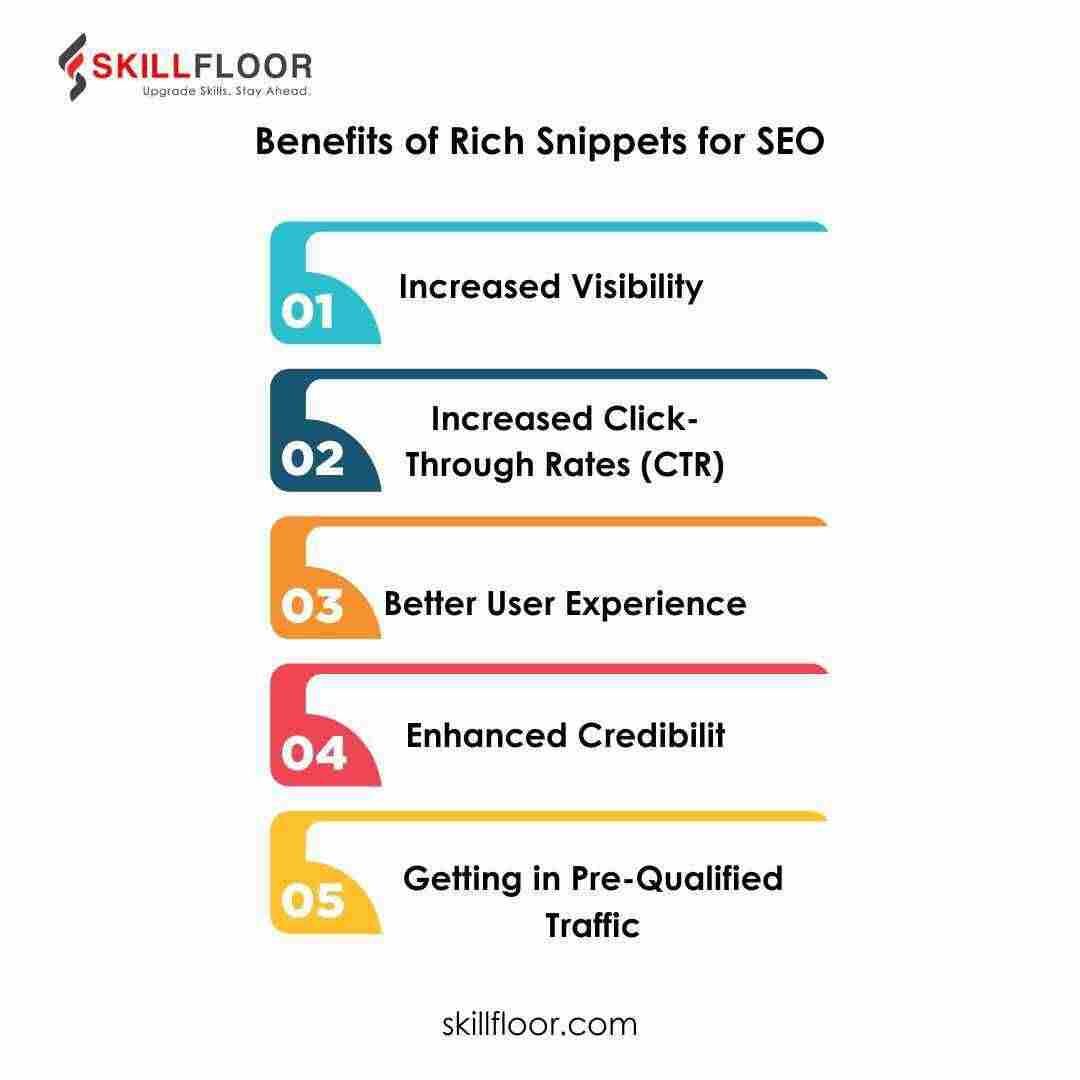Exploring the Benefits of Rich Snippets for SEO
Explore how rich snippets boost SEO by enhancing visibility and click-through rates. Learn the benefits of structured data and implementation tips.

In the current digital environment, webmasters and content producers have to understand the advantages of exploring the benefits of rich snippets for SEO. Rich Snippets are structured data markup that website owners can incorporate into their current HTML to help search engines understand the content of the pages and possibly provide users with more informed results. Search engine rankings and exposure can be raised by integrating rich snippets, which is essential for drawing in high-quality traffic. Although they have no direct effect on rankings, they do increase the ranking of web pages in SERPs, which is likely to increase click-through rates. This part of search engine optimization concentrates on increasing both the volume and quality of website traffic, giving businesses a competitive advantage in the internet market. These snippets are crucial for efficient SEO efforts because they help provide readers with focused information, like price ranges and ratings.
What Are Rich Snippets?
In simple terms, rich snippets enhance search results that offer more details than just the title, URL, and meta description. They make use of HTML, which has structured data markup built into it, helping search engines understand the content of your pages. For e-commerce sites, this additional data can contain things like product prices, availability, ratings, and reviews; for food blogs, it can include recipe ingredients and cooking times. Consider Rich Snippets as an online shop that provides visitors with an overview of your website prior to their arrival. They give your search results an extra sparkle, which instantly makes them appealing and informative.
Types of rich snippets
Rich snippets are an excellent method to differentiate your website in search results and provide visitors with a preview of what to expect on your page. Depending on your content, you might think about implementing the following popular sorts of rich snippets:
Product Snippets: Located directly in the search results, these snippets provide crucial details about your products, such as price, availability, and review ratings. They work well in drawing the attention of someone who is window shopping.
Review Snippets: Presenting reviews and rankings for books, films, products, and other items that can be reviewed, these snippets help with establishing credibility and trust with visitors prior to their visit to your website.
Recipe Snippets: Suitable for food blogs and cookery websites, these snippets provide ingredients, cooking times, caloric content, and even user-rated stars. It's similar like serving up a sample of your cuisine via the search results!
Event Snippets: Advertising Occasions? To help participants plan their visit, these snippets can display the event's date, location, and time.
Video Snippets: In the search results, video snippets, if you have any, may contain a thumbnail image and a brief description. This can greatly raise the possibility that someone will click through and view your video.
FAQ Snippets: These brief responses accompany questions in content that answers frequently asked queries. This is very helpful for giving users instant information without making them leave the search page.
Rich snippets enhance user experience from the search results and increase the probability that your website will draw in more relevant traffic.
How Rich Snippets Work
Rich Snippets work by using structured data, a standardized framework for classifying content on a page to provide information about it. Your web page's HTML code contains this data integrated within it utilizing several Schema.org-defined schema types.
This is a simplified description of how Rich Snippets function:
-
Add Structured Data: You add particular schema markup to the HTML of your website. Either manually or by using tools and plugins that provide the required code for you, you can accomplish this.
-
Crawling and Indexing: Structured data on your website is recognized by search engines like Google as they crawl it.
-
Enhanced Display: The search engine shows the enhanced snippet, which includes extra information you've marked up, in the search results when your material is relevant to a certain query.
For example, if you manage a food blog and your recipes are organized using structured data, Google can present search results that include snippets of information about ingredients, cooking times, and ratings.
Benefits of Rich Snippets for SEO
Rich Snippets are an essential tool for website owners as they provide numerous SEO benefits. Here's why you need to think about putting them into practice:

-
Increased Visibility: Your listings will stand out in search results thanks to Rich Snippets. They are able to capture the user's attention more successfully than regular snippets since they are more thorough.
-
Increased Click-Through Rates (CTR): When people receive more relevant information directly from the search results, they are more likely to click on your link thanks to enhanced snippets. Your CTR may increase significantly as a result of this.
-
Better User Experience: By giving consumers important information up front, Rich Snippets enable users to make more educated decisions. This can lower bounce rates and enhance the user experience overall.
-
Enhanced Credibility: You can increase credibility and trust by including rich data in your snippets, such as reviews and ratings. Clickthrough rates are higher for results that appear more trustworthy and educational.
-
Getting in Pre-Qualified Traffic: Rich Snippets draw in people who are specifically searching for what you have to offer because they give more context about your content. More qualified leads and possibly improved conversion rates result from this.
Best Practices for Implementing Rich Snippets
Use these best practices to get the most out of Rich Snippets:
Choose the Correct Schema: Different schema markups are needed for different types of content. Find the right schema for your content be it a product, recipe, or event by using Schema.org.
Use Google’s Structured Data Testing Tool: Make use of Google's Structured Data Testing Tool to make sure your markup is implemented correctly and will appear as expected in search results before putting it live.
Keep Content Accurate and Updated: Ensure that the data you supply via structured data is correct and current. This is essential to preserving credibility and making sure your snippets are still pertinent.
Avoid Overloading with Markup: Although it may be tempting to markup every piece of content, concentrate on the elements that will benefit consumers the most. Markup that is overdone may look spammy.
Track Performance: To keep an eye on the effectiveness of your snippets and make any revisions, use tools such as Google Search Console. This will enable you to optimize the advantages and improve your plan.
Rich Snippets give you an advantage in SEO by improving the way your website appears in search results. In addition to improving click-through rates and contact, they draw in more qualified, engaged visitors. By incorporating structured data into your content, Rich Snippets enable search engines to provide more thorough and educational results. By following to best practices, you can make sure your Rich Snippets work well and stay relevant over time.




























































